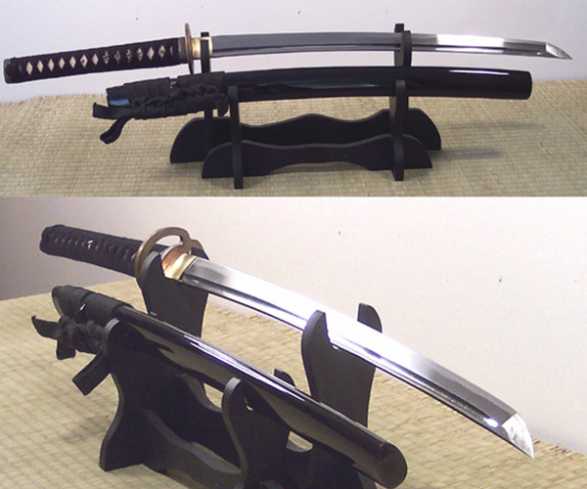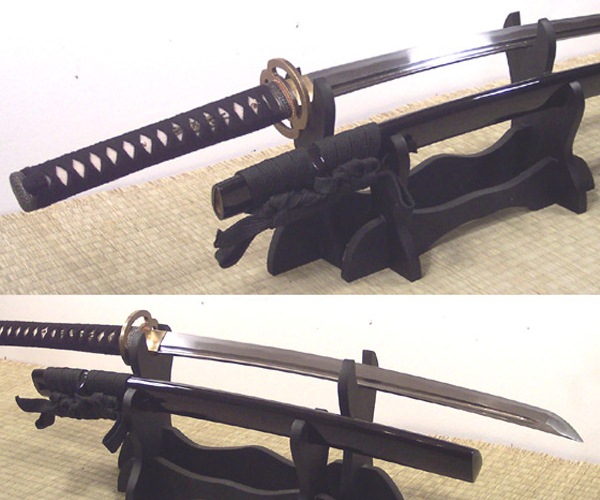Cheness 9260 Tenchi Ko Katana
DISCONTINUED
SOLD OUT & UNAVAILABLE
Shorter Length Blade for Indoor Use and Use in Confined Spaces. Available with bo-hi (pictured) or as a solid bodied blade.
With a standard length, double pegged 10.5" tsuka (handle) and a 21" blade forged from the same revolutionary 9260 spring steel as the Cheness Cutlery Heavy Duty Dojo Cutters, this eminently durable shortsword is designed as the perfect compliment to the extremely popular Tenchi Katana. Featuring the same distinctive solid brass 'Miyamoto Musashi' Double C-Ring tsuba hand guard, this mean looking sword makes an incredibly tough cutter in its own right.
For a closer look, see the full review here on SBG.
MUST READ NOTE REGARDING CHENESS CUTLERY SWORDS
Cheness Cutlery Swords are designed by Martial Artists for Martial Artists. Their goal is and always has been to simply offer an affordable entry level practice sword to beginners in iaido and iaijutsu and when first released in 2005 truly revolutionized the sword market for until that time, there were few to no entry level Katana.
Cheness swords were never meant to be collectors pieces, display pieces, or art sword quality. There are numerous other manufacturers and individual smiths in the industry that serve those needs (click here for our full selection of Japanese swords). The reason being the same as with all other hobbies, refinement will come with a price.
Because of this, certain shortcuts must be taken in the manufacturing process and are NOT considered to be defects. Because of this, we will not accept returns on any swords that have the following features:
- The polish of each sword is a working polish known as a 'Tameshigiri' polish and is somewhere between 400 to 600 grit. As they are handmade and subject to extensive handling, they do get scuff marks and minor stains on the blade and components.
- Each blade is hand hammered, shaped to the eye, and then tempered and quenched. This process causes all types of steel to contract, twist and warp to some degree -with 9260 being one of the hardest steels to keep straight - so you should not expect the blade to be perfectly straight like a lazer. Even if slightly off center or imperfect, it will still cut perform for Tameshigiri and you can be confident in the tempering.
- The blades have considerable hira-niku (meat) on them for heavy cutting and will generally feel somewhat dull to the causal observer. It will not slice paper or shave hair off your arm. It WILL cut tatami mats or bamboo or other targets that were traditionally used to simulate human limbs. With only a little work however, it is quite possible to sharpen it to any degree desired.
- The cotton ito wrap is tight enough for use, but is not going to be as tight as silk or leather. Habaki, Seppa, Fuchigashira, etc are free floating and pinched into place by friction forces like a traditional Katana, but some minor adjustments may be necessary out of the box.
- Mekugi pegs are angled by design to create a wedge and optimize the double mekugi configuration. The bottom peg is made of brass, the top, bamboo which results in an overall stronger design and was recommended by a senior Japanese JSA Sensei.
In short, you should not expect an art sword or something perfect out of the box. You will almost certainly need to make some adjustments or even a complete DIY overhaul (we have many free tutorials on how to do this right here on the main SBG website). But for those of you who don't mind a rough and ready sword, or who wish to take it to a higher level, you will find these blades to be extremely long lasting, tough and worth every penny.
In summary, Cheness puts it like this:
The issues can all be addressed by the end user if they so choose. After receiving the sword, you can adjust the components, add a high-grit diamond paste polish, deburr the blade to slice paper, polish the components, etc. to make it as refined as you choose. However, these are not the features we strive for and should not be expected of the sword out of the box. If a highly refined sword is what you are after, you will either need to be prepared to perform these refinements yourself or should purchase a higher end sword from a different manufacturer.
Please note, as to be expected issues like cracked blades, broken handles, etc are of course subject to our standard warranties and return policies.
How to Use
Materials and Construction
Warranty Info
Return Policy
Featured positive reviews:
I bought this along with the Tenchi Katana. The Katana was pretty good and really had no serious issues. The Ko Katana had some issues that I was able to take care of but not everyone would know how to do these repairs. First issue was the Tsuka (handle) was extremely tight and obviously hammered on. Had two cracks running in about a half an inch. The Fuchi (handle collar) is pretty thin and cheap so I didn't trust it to contain the cracks under use. Glued the wood cracks and epoxied the collar onto the handle. Not like I'm ever going to remove the Ito (braid) anyway. The next issue was taking care of the handle fit to the Nakago (tang). A little careful filing and I got the fit pretty well. The biggest issue was the fit of the Saya (scabbard). It was extremely loose and did not hold the sword much at all. I had some wood veneer (birch?) and had to put some at the top and bottom of the Koiguchi (scabbard mouth) and even some on each side before I got it to be tight. Some very careful filing with some jewelers files and I got it where I wanted it. Fairly snug but not too tight. This blade and the Katana blade were somewhat sharp but running them on the leather strop on my belt sander with green compound brought them to where I wanted them. The blades on these swords are not polished very well and for the price you wouldn't expect it to be. I was ambitious on this blade and wet sanded it with 400, 600, 800, 1000, and 1500 grit paper and it looks a lot better than how it came. Haven't done the Katana yet, but I will. Overall these are good blades for the price. Just don't expect it to be perfect or pretty. The wrap is tight, but it is cotton. The Tsuba (guard) is a nice piece of brass, but the rest of the fittings are cheap and thin. They work for a beater use sword. You may have to do some maintenance on these or you may end up sending them back. Google the fixes on YouTube and it is nothing complicated. Overall I think they are good for the price and the little bit of repair work I did and I'm pretty happy with them.
Our responseGood to see you taking the swords to the next level - we have a lot of DIY tutorials on the various fixes and modifications you did on our main site. We also have an article about Tight and Loose Saya Fixes which explains the most common causes of ill fitting saya and what to do about it..









